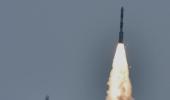The US space agency also warned that the risk of debris colliding with the International Space Station has risen by 44 per cent since Mission Shakti.

India shooting down of one of its own satellites was a "terrible thing" as it created about 400 pieces of orbital debris, the chief of National Aeronautics and Space Administration has said, warning that the risk of debris colliding with the International Space Station has risen by 44 per cent since the Indian anti-satellite weapon test.
Prime Minister Narendra Modi announced on March 27 that India has achieved a "historic feat" by shooting down its own low-orbit satellite with a ground-to-space missile, making the country a "space power."
Only three other countries -- the United States, Russia and China -- have anti-satellite missile capabilities.
NASA Administrator Jim Bridenstine said about 60 pieces of debris have been tracked so far and out of which 24 are going above the apogee of the International Space Station, the point of the space station's orbit farthest from the Earth.
"That is a terrible, terrible thing to create an event that sends debris and an apogee that goes above the international space station. That kind of activity is not compatible with the future of human spaceflight that we need to see have happen," he said at a NASA townhall with employees on Monday.
"The Anti-satellite weapons test by India last week has resulted in about 400 pieces of orbital debris," he said.
WATCH: Simulation of A-SAT BMD interceptor missile fired by India
Bridenstine said not all of the pieces were big enough to track and the NASA is right now tracking objects which are 10 centimetres or bigger.
"Some 60 pieces of orbital debris have been tracked so far, 24 out of which poses risk to the ISS," he said.
India has said the test was done in the lower atmosphere to ensure that there is no space debris. "Whatever debris that is generated will decay and fall back onto the earth within weeks," the ministry of external affairs said soon after the test.
By conducting the ASAT test, India was not in violation of any international law or treaty to which it is a party to or any national obligation, it said.
Interestingly, Bridenstine is the first top official from the Trump administration to come out in public against the India's ASAT test.
A day after India successfully carried out its ASAT test, acting US defence secretary Patrick Shanahan warned that the event could create a "mess" in space but said Washington was still studying the impact.
Bridenstine said the NASA is "learning more and more every hour" that goes by about this orbital debris field that has been created from the anti-satellite test.
"Where we were last week with an assessment that comes from NASA experts as well as the Joint Space Operations Center (part of US Strategic Command).. is that the risk to the International Space Station has increased by 44 per cent," Bridenstine said.
"We are charged with commercialising of low earth orbit. We are charged with enabling more activities in space than we've ever seen before for the purpose of benefiting the human condition, whether it's pharmaceuticals or printing human organs in 3D to save lives here on earth or manufacturing capabilities in space that you're not able to do in a gravity well," he said.
"All of those are placed at risk when these kinds of events happen," Bridenstine said as he feared India's ASAT test could risk proliferation of such activities by other countries.
"When one country does it, other countries feel like they have to do it as well," he said.
"It's unacceptable. The NASA needs to be very clear about what its impact to us is," he said.
The risk from small debris as a result of the ASAT test to the ISS went up 44 per cent over a period of 10 days. "So, the good thing is it's low enough in earth orbit that over time this will all dissipate," he told his NASA colleagues.
The ISS is a habitable artificial satellite, orbiting the Earth at an altitude between 330 and 435 km. It is a joint project between space agencies of US, Russia, Japan, Europe and Canada, and serves as a research laboratory for scientists to conduct space experiments.
As many as 236 astronauts from 18 countries have visited the space station, many of them multiple times, since November 2000.
Bridenstine said a lot of debris from the 2007 direct ascent anti-satellite test by China is still in the space.
"And we're still dealing with it. We are still, we as a nation are responsible for doing space situational awareness and space traffic management, conjunction analysis for the entire world," the NASA chief said.
"The International Space Station is still safe. If we need to manoeuvre it, we will. The probability of that I think is low. But at the end of the day we have to be clear also that these activities are not sustainable or compatible with human spaceflight," he said.










